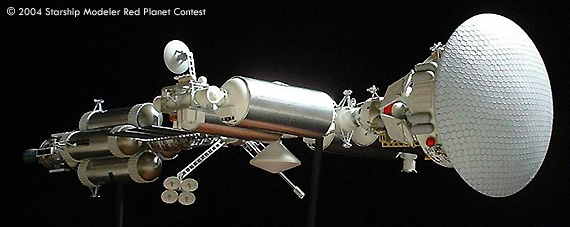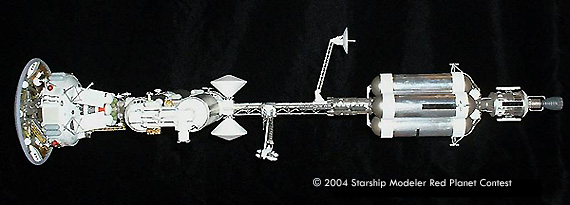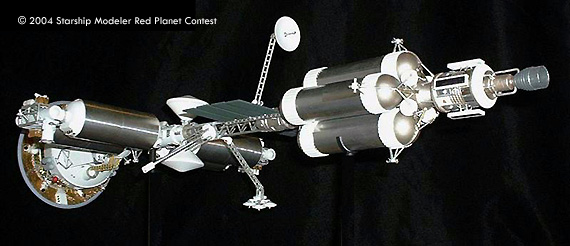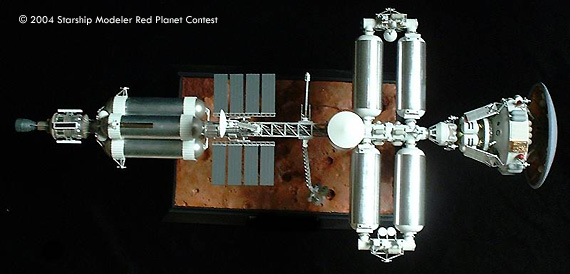
Scale: 1/144
Sometime in the distant future, between now and never........
"Mission control......Tharsis base here.......the Aquila has landed".
Built in orbit by a joint international effort, the nuclear powered Ulysses carries a crew of six, the Aquila lander, and two rovers to Mars orbit. Artificial gravity is generated by spinning the whole ship around its long axsis to provide Mars normal gravity on the outer decks of the crew modules for the outbound trip and a return to Earth normal gravity for the trip home.
The two rovers (encased in aerocapture shells) are sent down first and driven remotely from the Ulysses to the primary landing location where cameras on the rovers are used to scout the area in order to provide detailed recon and film the actual landing, and the later ascent at the end of the surface mission.
The Aquila and crew then descend to the surface for a 1.5 year stay. After landing, four solar arrays are deployed to provide backup/emergency power. Once the crew descends from the ascent module into the lower two-deck hab module the main nuclear generator is started and atmospheric processors begin to provide oxygen for the crew, and fuel (oxygen/methane) for the rovers and refill the six tanks that fueled the main descent engine.
In orbit, the Ulysses continues to run automatically and, via Earth control, to study the Mars environment, including its two moons Phobos and Diemos, and provide relay communications between the lander and Earth.
At the end of their one and a half year stay a two-stage-to-orbit ascent vehicle then returns the crew to orbit where the Ulysses has been waiting to bring them home to Earth.

General Specifications
Ulysses:
- Length: 216ft.
- Width: 134.4ft.
- Propulsion and Main Power: Nuclear Thermal Reactor, 2 reactor radiator arrays, power conversion module
- Fuel: 4 Liquid Hydrogen tanks
- Connecting Truss: Main communications antenna, Secondary com array, Magnetometer boom
- Crew Modules: 2 Habitation Modules, 1 Laboratory/Medical Module, 1 Life Support/Storage Module, 2
(P/S) instrament/experiment palates and secondary docking port, central conecting module
with lander docking port and 2 rovers
Aquila Lander:
- Length: 66ft.
- Width: Hab module - 36ft. Aerocapture shield - 58.8ft. diameter
- Propulsion: Chemical (Oxygen-Methane)
- Power: Nuclear primary with solar backup

The Model
Inspiration for the general design is from the Mars One Crew Manual published in the 80's, particularly in the layout and look of the four hab modules, but I decided to go nuclear instead of the sticking with chemical propulsion that is outlined in the book, and things kinda took off on their own from there.
Mainly built from a bash of three kits - 2 Revell Space Operations Control Center kits for the hab section and truss assemblies, and an even older MPC Pilgrim Observer kit for the lander and engine, and a smattering of various parts from the parts box. I wanted the nice, neat, shiny look of white and aluminum to reflect the look of todays space stations and spacecraft, so I used aluminum tape to cover the tubes that form the hab modules and fuel tanks, painted the rest with various white, gray shades, and metalic colored paints, and accents of gold foil. Both antennas on the truss articulate. The lander attatches to the main ship via a long screw that runs up the lander's main engine nozzle through the two ascent stages and into a small nut inside the docking port. The front heat shield snaps on to (and off of) the folded landing gear feat, which also fold out for landing as do the solar panels. The aeroshell was vaccuformed over a glass desk lamp cover. Both the stand for the model as well as the bit of scenery for the lander are made from a spray-on foam packing material that dries on one side with a lunar-like landscape complete with craters and textures that when painted look pretty realistic. For the Lander scenery I used a section that wasn't cratered and just added some crushed lava rock.
The model measures 2 feet overall.

Image: Left/rear view, on the stand
Image: Aquila, on the ground
Image: Aquila, in pieces

